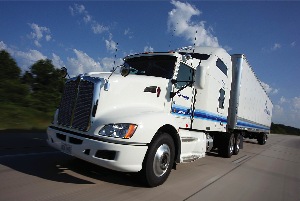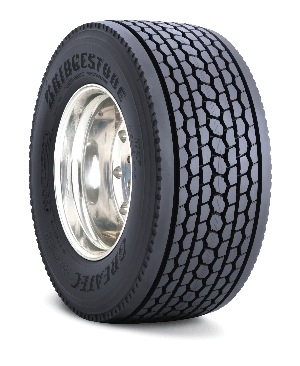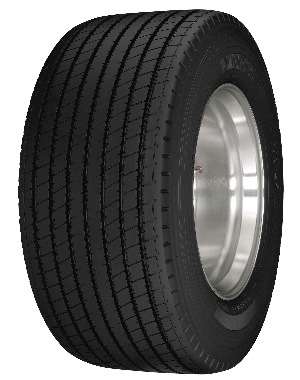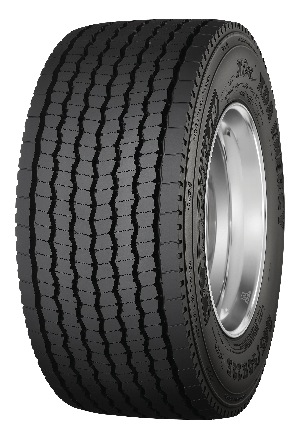As the cost of diesel fuel continues to climb, commercial trucking fleets are looking for ways to save dollars. And because tires make up a large part of the budget, more than ever fleets are turning to tire dealers seeking ways to leverage savings, including adopting super wide tires.
When commercial customers come asking questions, smart commercial tire dealers must have answers. In the case of super wide tires, there have been claims of various benefits mixed with concerns from some fleets. To help dealers sort out fact from fiction, a handful of tire manufacturer representatives have offered their expertise on the subject.
The Changing Market
Super wides (sometimes, and slightly erroneously, called wide-base singles) are a newer phenomenon. Some would argue that they are of the same family as “super singles,” but they quite different.
According to Guy Walenga, director of engineering commercial products and technologies for Bridgestone Americas, wide-base tires first entered the market in the mid-1960s and were bias tube-type. Next came bias tubeless, then radial tube-type and tubeless. Primarily these were used on large haul vehicles – dump trucks, cement mixers, waste trucks – and had limited ability on the highway.
Michelin North America’s Don Baldwin, market segment manager of X One, says the tiremaker introduced super wide tires to the trucking industry with the launch of the X One tire in 2000. “While other ‘super single’ tires existed in the market prior to 2000, these tires were fundamentally different and not specifically designed to replace a dual tire set-up in over-the-road service,” he adds. “Super single tires are 65 aspect ratio tires that are substantially taller in diameter than standard or low-profile over-the-road dual tires and are primarily intended to operate in the steer position on vocational trucks with high axle loads. New generation super wide tires are 50 and 55 aspect ratio tires that are the same diameter as low profile 22.5 and standard 22.5 tires.”
Early forms came in different sizes, primarily from overseas markets, says Rick Phillips, director of commercial sales for Yokohama Tire Corp. “The manufacturing technology has improved, allowing the tires to be produced today with a more flat profile across the tread area,” he adds. But the product has settled into the 45 to 55 series range.
Baldwin estimates super wide tires are on more than 700,000 wheel positions today. “We continue to see sales increasing for X One tires. In 2010, X One tire sales outpaced 2009 by nearly 50% as more and more fleets chose to make the switch. We expect to see continued growth over the next several years as more fleets jump on board with the single tire concept.”
Bridgestone’s Walenga estimates that super wides currently amount to about 4% of the total truck tire market. He adds that interest in the segment is increasing, so there should continue to be growth.
Yokohama’s estimates are a little higher, hovering around 5% to 7%, according to Phillips. “The segment appears to have settled a bit,” he says. “I think there was a lot of interest at first and frankly, many of these tires were put into wrong applications where they just didn’t perform – mainly in severe applications, extremely heavy loads and fleets with poor or no maintenance programs. But now we are seeing it settle into those special niche markets where it provides benefits and also performs well.”
Fleet Concerns
As super wides have proven to be a viable option in the right applications, more fleets are exploring the possibility of making the switch. Initial fleet concerns included availability and cost, as well as concerns about having only one tire at each axle end: What happens in the case of a sudden air out? Are they too heavy for one man to safely maneuver and mount the assembly on a vehicle?
“None of these are deal breakers,” Walenga says. “A sudden air out will not necessarily cause a driver to lose control, but he must stop – he cannot ‘limp in.’ But he shouldn’t try to limp in on the remaining tire of a dual either, he should stop.
control, but he must stop – he cannot ‘limp in.’ But he shouldn’t try to limp in on the remaining tire of a dual either, he should stop.
“There are methods and tools to make mounting and handling the tire/wheel assembly easier,” he adds. “As for the cost, like most things, customers should shop around.”
Baldwin adds that early on in the 2000s, some fleets had concerns about availability, but with the vast availability of X One tires now, along with Michelin’s OnCall ERS service, this is no longer a sticking point for fleets if they are out on the road and need a tire.
The purchase price usually is about the same as two duals, or sometimes slightly higher, in similar applications, Yokohama’s Phillips says. “Performance should be close, but in some cases might be less than two duals. However, there will be a slight benefit in fuel efficiency and a noticeable weight savings. An analysis needs to be performed to make sure the benefits outweigh the trade-offs – if they do, super wides are a great investment.
“Most fleets that have heartburn over making the change were simply sold a product they should not have purchased in the first place,” he adds. “This is a great concept but does have limitations and is not for everyone, everywhere. Every fleet and application will be different, but the tire’s sweet spot seems to be regional and bulk hauler fleets.”
To help get commercial customers on board, tire dealers must learn as much about the fleet and its individual needs as possible. In addition, dealers have the ability to get tire manufacturers involved by putting on technical training classes for fleets, Walenga adds.
Service and Benefits
When it comes to service, no special equipment is needed for super wides, other than perhaps a larger inflation cage. Another added bonus for tire dealers is the relatively small number of SKUs required to cover most of the market.
“We have seven SKUs that will meet the needs of most long haul and regional fleets and another two SKUs for vocation fleets,” Michelin’s Baldwin says.
As far as retreading, super wides offer the same options as duals for added value in the cradle-to-grave lifecycle. “Super wides can and should be retreaded to make them more competitive with duals in overall cost per mile,” Walenga says. “Fleets and dealers do not have to treat them any differently than duals in order to get the most in terms of retreadability.”
He adds that dealers/retreaders may have to invest in newer buffing and inspection equipment to better service super wide customers.
When helping fleets determine the benefits of super wides, dealers have a few areas from which to choose.
Yokohama’s Phillips points to weight savings as the biggest benefit, saying the singles are 700 to 800 pounds lighter than duals, depending on the original configuration.
“One super wide and its wheel weigh less than the duals and wheels they replace,” Walenga says. “This weight savings can become additional revenue-producing payload. A fleet that grosses out before it cubes out, hitting its max legal load capacity while there is still more room in the trailer, would be able to take the weight saved by replacing duals with super wides and add that much more payload on the trailer.
“If, on the other hand, the fleet is cubed out and cannot fit any additional load on the trailer, then using the lighter weight super wide would return no measurable improvement in freight efficiency.”
Walenga says ease of inflation maintenance is another plus. When it comes to inflation maintenance, there is only one tire to check and adjust with super wides, and the valve is easily accessible. With duals, it is sometimes difficult to get to the inside tire valve, so the inside tire may not get the same level of maintenance as the outside tire, he explains.
“Other than these two issues, super wides and duals compete at all other measures of performance, including removal mileage, rolling resistance, retreadability, purchase price and overall cost per mile,” Walenga adds.
While Phillips and Walenga say super wides don’t significantly outperform SmartWay-verified, fuel-efficient duals in terms of fuel savings, Baldwin says a 2009 U.S. Department of Energy report showed that Michelin’s X One tires were up to 9.2% more fuel efficient than dual tires.
He says that since 2000, X One tires have saved more than 72 million gallons of fuel.
Only the fleet – with the help of a smart tire dealer – can see if all of the numbers add up and if one, in fact, equals
two.













